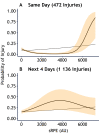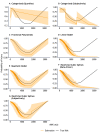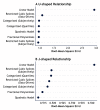Not straightforward: modelling non-linearity in training load and injury research
- PMID: 34422292
- PMCID: PMC8351477
- DOI: 10.1136/bmjsem-2021-001119
Not straightforward: modelling non-linearity in training load and injury research
Abstract
Objectives: To determine whether the relationship between training load and injury risk is non-linear and investigate ways of handling non-linearity.
Methods: We analysed daily training load and injury data from three cohorts: Norwegian elite U-19 football (n=81, 55% male, mean age 17 years (SD 1)), Norwegian Premier League football (n=36, 100% male, mean age 26 years (SD 4)) and elite youth handball (n=205, 36% male, mean age 17 years (SD 1)). The relationship between session rating of perceived exertion (sRPE) and probability of injury was estimated with restricted cubic splines in mixed-effects logistic regression models. Simulations were carried out to compare the ability of seven methods to model non-linear relationships, using visualisations, root-mean-squared error and coverage of prediction intervals as performance metrics.
Results: No relationships were identified in the football cohorts; however, a J-shaped relationship was found between sRPE and the probability of injury on the same day for elite youth handball players (p<0.001). In the simulations, the only methods capable of non-linear modelling relationships were the quadratic model, fractional polynomials and restricted cubic splines.
Conclusion: The relationship between training load and injury risk should be assumed to be non-linear. Future research should apply appropriate methods to account for non-linearity, such as fractional polynomials or restricted cubic splines. We propose a guide for which method(s) to use in a range of different situations.
Keywords: injury; methodological; statistics; training.
© Author(s) (or their employer(s)) 2021. Re-use permitted under CC BY-NC. No commercial re-use. See rights and permissions. Published by BMJ.
Conflict of interest statement
Competing interests: None declared.
Figures




References
-
- Griffin A, Kenny IC, Comyns TM. The association between the acute: chronic workload ratio and injury and its application in team sports: a systematic review. Sports Medicine 2019:1–20. - PubMed
-
- Andrade R, Wik EH, Rebelo-Marques A, et al. . Is the acute: chronic workload ratio (ACWR) associated with risk of Time-Loss injury in professional team sports? A systematic review of methodology, variables and injury risk in practical situations. Sports Med 2020;50:1–23. 10.1007/s40279-020-01308-6 - DOI - PubMed
-
- Gamble P. Reducing injury in elite sport-is simply restricting workloads really the answer? N Zeal J Sports Med 2013;36.
LinkOut - more resources
Full Text Sources
